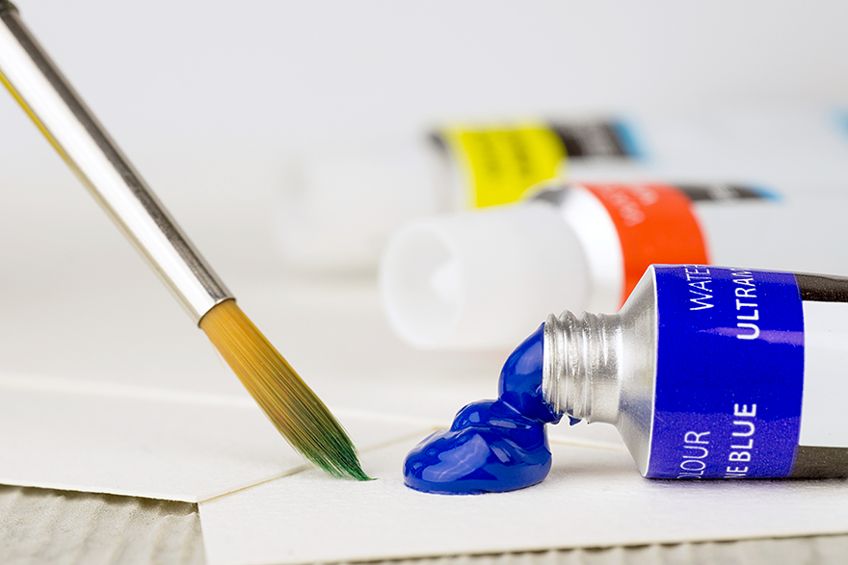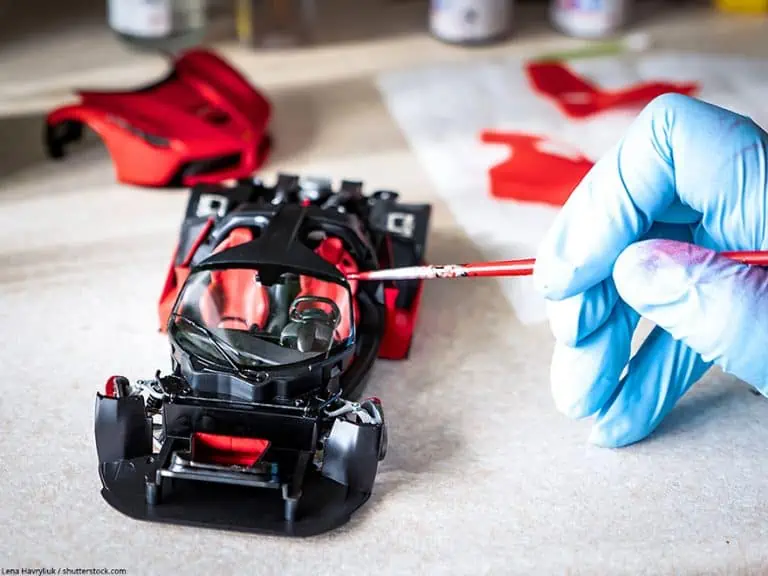Is Acrylic Paint Safe for Skin? – Complete Overview and Guide
This post may contain affiliate links. We may earn a small commission from purchases made through them, at no additional cost to you.
Acrylic paints are a popular medium when it comes to painting on canvas and other arts and crafts projects. However, even though acrylic paint is easily cleaned up using some soap and water, the paints might not be the best option for certain applications, such as painting on your skin. In this article, we will be discussing things like can you put acrylic paint on your face and how to remove acrylic paint from skin. Ultimately, is acrylic paint safe for skin? By the end of this article, you should have a clear answer to this question.
Table of Contents
Types of Acrylic Paint
The oldest medium artists have used over the years are oil-based paints, however, these are more toxic, and you require solvents for cleaning. So, when a less toxic and easy to clean painting medium like acrylic paints were manufactured, it became quite popular.

Acrylics have various consistencies that closely resemble oil paints, so many painting techniques are similar as well. Below are a few different kinds of acrylic paints.
| Acrylic Paints | Description |
| Heavy Body Acrylic Paints | Thick viscosity with a smooth consistency like butter |
| Soft Body Acrylic Paints | Low viscosity, creamy consistency for great coverage |
| Fluid Acrylics | Thickness like double cream |
| Acrylic Inks | Thin consistency that is great for layering washes and other techniques |
| Acrylic Gouache | Provides a creamy, matte, opaque watercolor finish effect that becomes water-resistant once dry |
| Acrylic Markers | Marker pens, which are great for more detailed work |
| Acrylic Spray Paints | Spray paints offer great coverage but need to be used in a well-ventilated space |
| Other Interactive or Open Acrylics | Can be used for certain techniques like wet-on-wet painting |
Then, you have your various grades of acrylic paints from professional to artist and student grade. These mostly differ in the quality and density of pigments used. The professional acrylics being of the highest quality, are more expensive but provide the most vibrant colors.
There are many different surfaces you can use acrylic paints on from paper to canvas, wood, fabrics, and clay. However, can you put acrylic paint on your face or skin? Many makeup professionals and fashion designers or artists use paints for body art. Many of us are also familiar with face paints at kids’ parties or events. Is acrylic paint safe for skin? This is a crucial question when dealing with a person’s health.
The best option would be to always read the product labels and instructions that are offered. If you decide on painting faces with acrylics, do not just go out and purchase any paints just because it says it is water-based or non-toxic and, therefore, must be safe to use on the skin. There are specific body and face paints that are a better option. The reason is that acrylic paints can contain toxic ingredients, let us have a look at what is usually found in acrylic paints.
Acrylic Paint Ingredients
The basic description of acrylic paints is that they consist of a combination of color pigments within an acrylic polymer emulsion. The acrylic polymer is a plastic substance that hardens when it dries. The acrylic paint does remain water-soluble while it is wet. However, more ingredients go into the process of making acrylic paints. These include things like initiators, that start the polymerization process, buffers that help to maintain pH balance, surfactants, defoamers, preservatives, and thickeners amongst other additives. Some acrylic paints can contain lead, ammonia, or even formaldehyde.

Not all acrylic paints are manufactured in the same way, so you will have to look for lead-free paints. As you can see, acrylic paint is not simply water and colorants, and with all these ingredients and processes in manufacturing, it might be sounding more and more like something you do not want to put on your skin. One of the main ingredients is pigments, which give your paint color. Most of these pigments are harmless and not toxic, however, some pigments can be toxic, and you should always look out for these. In most cases, if the pigment name has a name similar to heavy metal, for example, lead, it is most likely toxic.
All paint products that contain these pigments should have a warning label.
Cobalt Pigment
The cobalt pigment of pure blue is expensive, and so any paints containing it will be expensive as well. These moderately toxic pigments can cause skin allergies and inhaling the pigment powder can cause asthma. Ingestion can also cause diarrhea and vomiting. The cobalt is obtained during nickel refining and was discovered in the early 18th century.

Cadmium Pigment
Cadmium is a rare pigment, so it is less likely you will find it in paints today. When exposed to this pigment over time, it is said to be carcinogenic and may cause other severe health issues. The pigment is mostly found in oil-based paints and is used by more professional artists that handle it with care.
The pigment was discovered in the early 19th century and was used to create vibrant red, yellow as well as brown colors.
Chromium Pigment
This greenish pigment has been known to cause allergic reactions and dermatitis in some individuals, especially for artists who use the paints often. The skin usually becomes red and itchy on contact.

Manganese Pigment
In its natural form, manganese can be found in leafy foods and nuts. However, the modern manganese pigment is a synthetic blue pigment. Manganese is known to be a toxic pigment, similar to cadmium and cobalt.
The genuine manganese pigment is difficult to come by, so for basic arts and craft purposes, it will most likely not be found in acrylic paints.
Is Acrylic Paint Safe for Skin?
Acrylic paints do not contain pharmaceutical-grade ingredients, which means it is not skin safe. Some paints are specifically manufactured for application to the skin; however, these should also not be left on the skin for too long and should preferably be washed off as soon as possible.

There are definite advantages when painting acrylic paints on canvas and other surfaces, however, there are no real advantages for painting faces with acrylics, or the body with acrylic paints. Some of the disadvantages of using acrylic paints on the skin are as follows.
| Acrylic Paint on Skin Disadvantages | Reasons |
| Toxicity | While generally non-toxic, some ingredients are considered toxic, especially if applied directly to the skin, or inhaled. |
| Dries Hard | Acrylic paints can be seen as a type of plastic, which hardens when it dries. This is great for painting on canvas as well as other surfaces, however, not on the skin. |
| Acrylic Paints Crack | Even if you apply it to your skin, once dry, it will begin to crack due to the body’s movement. |
| Difficult to remove Once Dry | When it dries hard on your skin, it will become difficult to remove. You will need more than soap and water, and peeling the paint off can be painful. |
Can you put Acrylic Paint on your Face?
The skin on your face is sensitive, so you should definitely not use acrylic paints on your face. Some may ignore the warnings and paint their faces with acrylic paints, and nothing may happen. However, it is not an ideal option, and you are risking your health in the process. An allergic response can be painful and unpleasant. Not only that, but it can also be difficult to wash off.

Some have found a way to make acrylic paints into face paints by including moisturizers, however, it is recommended you purchase non-toxic face paints instead. Some products are perfect for face painting, which is what you are looking for, especially at a children’s party. These paints are safe to use and easier to remove. The same applies to your hands and the rest of your body. Bodypaint art has been around for many years and is something fun to do at parties or events. However, not only can it cause skin irritation, but acrylic paints do also not perform well, form cracks, and is not easy to clean off.
You do not want to use acrylic paints on a child’s hand when doing an art project.
Whenever you do get acrylic paints on your hands, it is best to wash them off straight away. Even small exposure to some toxic ingredients can cause problems when used over time. Acrylic paints should not be used by children younger than three and older kids should be supervised. If you are painting with your hands and you are using acrylic paints, you should rather first put on gloves.
What Should You do if Acrylic Paint is Swallowed?
Accidents do happen, and in the case of swallowing acrylic paints, you should do the following. First, do not let children younger than three paint with acrylics and store you’re your paints where little hands cannot get to them. When only an extremely small number of paints, about the size of a fingernail or less, it should not be a major problem.

Wash your hands to take the paint off and drink plenty of water. If you are concerned, or a larger amount of paint has been ingested, the best response would be to contact your doctor or phone poison control. Make sure to rinse the mouth out and gargle with some saltwater. You can also brush your teeth and mouth to help remove the paint.
Paints That are Best for the Skin
In some cases, acrylic paints applied to the skin might not do anything, and in other cases, there could be a severe reaction. So, the best paints to use on the skin would be cosmetic-grade paint products. Some people even have reactions to these products, and if you know you suffer from allergies and have sensitive skin, it is recommended you do a patch test first before applying the paint.
This simply means applying a small amount of paint onto the inside of your arm. Wait a few minutes, and if the paint causes a reaction, you will know not to use it.
When it comes to adults using body paints for professional reasons, these can be rather expensive. These include metallic, latex, and alcohol-based body paints, henna, and other commercial body paints. However, there are also face and more affordable body paints and still provide vibrant colors. When choosing body paint, it is best to look out for the following.
Hypoallergenic Paint
Every person’s skin is different, some might be extremely sensitive, while others do not seem to have any problems. This is why purchasing products that say they are hypoallergenic is important, as these can usually be applied to all skin types.

The Paint Opacity
This is a factor many do not consider when purchasing body paint. To make the colors stand out more, whatever the complexion, paint with a higher opacity is recommended. This means you will use less paint as you do not have to build up paint layers to gain the effect you want.
The painting process will also be done that much faster.
Is the Paint Waterproof?
People tend to sweat or cry, so getting a waterproof product can help prevent the paint from smudging and coming off prematurely. This is especially helpful for paints that need to remain for some time, for example, stage performances, events, and parties.

Easy to Clean
You do not want to have to sit for hours removing the paint, so even if the paint is waterproof, it should not be difficult to remove. You should easily remove the paint with a cloth and some water.
This will help if you have to wash and clean younger hands and faces.
Paints for Younger Kids
Some parents like to make special keepsakes like a baby’s foot or handprint. For this, there is a special non-toxic ink that can be used. Some other recommended choices include tempera paints and the Crayola washable paints.

Here are some points considered safe to use with smaller children who love to get their hands dirty. All of these products should be approved and have an AP (Approve Product) seal and should have a code from the American Society for Testing Materials (ASTM).
| Type of Paint | Reason |
| Activity Paint | These are usually water-based and you can apply them to multiple surfaces. They are also easy to remove |
| Tempera Paint | These paints dry quickly, do not crack, are easy to wash off, and are non-toxic |
| Watercolor Paints | Water-based and easy to remove |
| Finger Paints | Safe to use and specially manufactured for this purpose |
How to Remove Acrylic Paint From Skin
Does acrylic paint wash off skin? Water-based paints can easily be removed with water whether the paint is still wet or dry. Acrylic paints can be removed easily if wet, however, once dry it becomes hard and is more difficult to remove. The paint can irritate the skin and block pores. Acrylic paints dry fast, so you will have to wash any paint off quickly.

So, the first option is to make sure to remove acrylic paints from your skin straight away. You can scrape lightly as you wash, then rinse the areas thoroughly. When the paint has dried, and soap and water are less effective, you can try using the following natural options along with something to scrub the paint away. For example, a nail scrub. Finish by wiping and rinsing the area thoroughly.
- Olive, canola, or other vegetable oil
- Mayonnaise
- Baby oil
- Butter or margarine
You could also try to peel the paint off, however, the hairs on your skin are stuck in the paint, which makes this method quite painful. The best method is, of course, preventative measures, meaning you should wear gloves when working with acrylic paints.
How to remove acrylic paint from the skin using other methods is as follows.
- Try using hand sanitizer
- Rubbing alcohol
- Vaseline
- Petroleum jelly
A Few Tips When Using Acrylic Paints
Painting with acrylic paints can be fun and there are many techniques you can use. You do not want to have to worry about if the paints are a health hazard, especially if you are painting and having fun with kids.
- Always read the paint product labels and find out more about the product you wish to purchase. As mentioned, paints can contain harmful chemicals that can cause skin reactions and other problems.
- If you have bought a paint you wish to use on the skin, first test it out and do a patch test to see if any skin reactions occur.

- When painting, even when using the proper non-toxic paints, never allow the paint to get near the eyes, nose, or mouth.
- It is a good idea to paint with acrylic paints in a well-ventilated area.
- When paint gets on your skin, always remove it immediately.
- Store paints in a safe place away from children and animals.
How to Make Skin Color With Acrylic Paint
We have been discussing if acrylic paint is safe to use on skin. So, for a bit of added fun, let us now consider how to make skin color with acrylic paint. Since there are many skin tones, it can be quite difficult to get just the right tone you are looking for. Skin color is not simply one color and there are different tones and accents you can add, so creating a “family” of the same base skin tone is recommended.

Always remember that acrylic paints tend to dry darker, so you will need to make your application a little lighter if you want to be more accurate. Always make notes of your mixing samples so they can be used as a reference in the future. When creating lighter and darker skin tones, some suggest using white and black. However, a better choice would be to use yellow to lighten a mixture, and to use black sparingly. To darken, you might want to consider using a small, equal amount of each primary color instead.
You can create a skin tone palette using the primary colors. It is best to have a photograph as a reference for the color you wish to create. Combine equal amounts of the primary colors, which should create a base brown color. This is perfect because each skin tone does contain different ratios of each color. You can adjust the ratio of primary colors as you experiment, however, begin using equal amounts. Once you have your base skin tone, you can begin to refine the color.
The initial blend might be quite dark, so to make it lighter, you can add white or yellow in small amounts.
Add more red to deepen the red tone. You can then refine by adding a little of each of the primary colors until you reach what you are looking for. Once you have experimented with the different ratios of colors, you can move on to creating highlights and shadows, and creating your skin color palette. For this, you can add a little black or white to adjust the paint tone. Mix different gradients of color to create different options for shadows and highlights.

Include more red color to create a blush tone. You can also again play with the colors by adding different amounts or each primary color. This might create some odd colors on your palette; however, you should consider that colors can be reflected in your skin tone. Maybe your subject is standing next to a green background, a small amount may reflect in the skin tone. These small details can help to make a painting seem more realistic.
Ultimately, acrylic paints are not made to be used on the skin. They tend to harden on the skin, may contain toxic chemicals, and are hard to remove when dry. Depending on the person, it causes skin irritation and is not recommended as a face or body paint. So, it is best to avoid acrylic paints on the skin in favor of water-based, non-toxic options that are specifically designed for use on the skin.
Frequently Asked Questions
Is Acrylic Paint Non-Toxic?
This is true if you are going to use it to paint on canvas or other regular surfaces in a well-ventilated area. The main issue comes when spraying the paints and sanding the dry paints. When doing this, you should wear a mask, eye protection, and gloves. Acrylic paints should also not be used by younger children as finger paints as the paints could contain harmful chemicals.
Can You Put Acrylic Paint on Your Face?
Painting faces with acrylics is not a good idea as the paints are not made to be used on the skin. Acrylic paints could contain toxic pigments and other additives which could cause skin irritation. The face is also a sensitive area, and you should preferably use specific face paint to prevent any problems. Acrylic paints dry hard and can cause cracking in the paints, so it is not an ideal choice. Also, removing acrylic paint once dry can be difficult.
Does Acrylic Paint Wash off Skin?
When the paint is still wet, you can wash off the skin, and since acrylics dry quite quickly, they should be washed off straight away. Once the paint dries, it hardens and becomes difficult to remove. There are various ways you can try to remove the paint, for example, using vegetable oil or rubbing alcohol and scrubbing the paint off.
Is the Smell of Acrylic Paints Safe?
Acrylic paints are generally low odor, if a tube of paint does have a strong smell, it should probably be replaced. Acrylic paints do contain small amounts of additives like ammonia, and some individuals can be sensitive to this. If a person works in a closed space for an extended period, it could cause, headaches, dizziness, nausea, and irritation to the eyes and respiratory system.
In 2005, Charlene completed her wellness degrees in therapeutic aromatherapy and reflexology at the International School of Reflexology and Meridian Therapy. She worked for a company offering corporate wellness programs for several years before opening her own therapy practice. In 2015, she was asked by a digital marketer friend to join her company as a content creator, and it was here that she discovered her enthusiasm for writing. Since entering the world of content creation, she has gained a lot of experience over the years writing about various topics such as beauty, health, wellness, travel, crafting, and much more. Due to various circumstances, she had to give up her therapy practice and now works as a freelance writer. Since she is a very creative person and as a balance to writing likes to be active in various areas of art and crafts, the activity at acrylgiessen.com is perfect for her to contribute their knowledge and experience in various creative topics.
Learn more about Charlene Lewis and about us.







